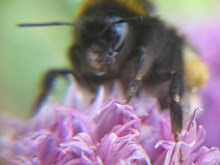
During the early parts of my research I was given the contact details of a couple of bumblebee experts. So, last autumn I contacted them both by email and here is the reply I got from one of them:
Hi there Rebecca
Quick answers to your questions:
When is the best time to start looking for bees?
Queens will start to emerge around March / April time. It's not a precise science and depends on the winter conditions. It is later as you go north. Emergence of the earliest bees usually coincides with the flowering of trees like willow.
What is the best method of searching and what equipment will I need?
In the spring look at willows and other flowering shrubs / plants (e.g deadnettles, alkanet, comfrey). Also look around tussocky grassy places. Queens may be emerging from these and also searching for new nests. A butterfly net is good if you want to catch them as are marking tubes.
How can I look at bees closely without causing them harm?
Depends what you want to do with them. To look at them close up use a marking tube. A more weighty and comprehensive work on all things bumblebee is the New Naturalist "Bumblebees" by Ted Benton.
Cheers
Matt
Dr Matthew Heard Head of Biodiversity and Conservation Management Group
NERC Centre fro Ecology and Hydrology
Wallingford
Oxfordshire
So, I've ordered my butterfly net and marking tubes. I've watched videos of a chap in USA giving tutorials on how to catch bees with a net - he made it look so easy and graceful (i have a horrible feeling I'll be rubbish at it - scaring every living creature for miles around). Getting hold of a copy of the Bumblebee book is proving a little more difficult - it's £80 or more so I'm going to try and get it from a library.

No comments:
Post a Comment